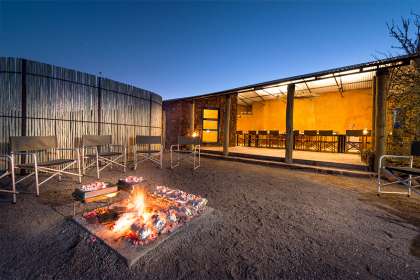Kunene
Kunene
The most north eastern of Namibia's 14 regions, is the Kunene Region. The region is bordered to east by the Atlantic Ocean and the famous Skeleton Coast which is an area named for its sun-bleached whale and seal bones, and gets its name from the Kunene River which forms the northern border with Angola. Opuwo is the capital of the Region and is situated about 720 km north-northwest from the country's capital Windhoek. Kunene, formerly known as Kaokoland is described as one of the most scenic of all the Namibian regions. The region, which is bordered by 2 rivers, the Kunene and the Hoanib River, covers an area of over 50 000 square kilometres, an area which is traditionally land belonging to the distinctive Himba ethnic group and the uniquely adapted desert-dwelling elephants of Namibia.
Kunene is known for its stark, mountainous landscape, but is also an area of unsurpassed tranquillity, especially at night when the sky is lit up by a canopy of stars. The region does not have many inhabitants, and sometimes you will see more desert elephants, rhinos, giraffes, mountain zebras and gemsboks than you do people. For bird viewing, a tropical belt of vegetation along the Kunene River is home to two of southern Africa's rarest birds – the rufous-tailed palm thrush and the Cinderella waxbill.
Many believe that the Kunene region represents one of the last true wildernesses in Africa and that it hosts a rare opportunity to conserve a vast desert ecosystem and enhance its people's quality of life. The region's community and government lands link the Skeleton Coast and Etosha national parks to form one of the world's largest conservation areas reaching across more than 60 000 square kilometres. Its rocky desert, arid grasslands and dry riverbeds provide a sparsely populated corridor for iconic wildlife, including the desert-dwelling black rhinoceros who finds their last free-ranging stronghold in the Kunene Region. Some of the natural attractions in the region include the beautiful Epupa and Ruacana waterfalls, and the Ondorusu and Enyandi rapids.
The last nomadic tribe in Nambia are called the Himba people and they are know as much for their beehive huts and distinctive appearance as for their hospitality and friendly spirit. The Himba people provide fascinating insight into how simple and peaceful life could be and a visit to the Kunene Region would not be complete with a visit to these intriguing people.
Malansrus Tented Camp
Game Reserve And Bush Lodge Accommodation in Twyfelfontein
Kunene
Malansrus Tented Camp accommodation is located near Twyfelfontein, Kunene, Namibia. Malansrus Tented Camp is situated on the banks of a sidearm of the Aba Huab River and nestled between beautiful shady Mopane trees, with spectacular views onto a set... …see more for bookings / enquiries and info.
Vreugde Guest Farm
Bed & Breakfast Accommodation in Outjo District
Kunene
Vreugde Guest Farm offers "full board" dinner, bed and breakfast accommodation in the Outjo District, Kunene, Namibia. Vreugde Guest Farm is a small, friendly family business, offering accommodation that is comfortable, rustic and elegant. …see more for bookings / enquiries and info.
Etendeka Mountain Camp
Bed & Breakfast Accommodation in Damaraland
Kunene
In the foothills of the Grootberg massif, set amidst magnificent scenery and the ancient Etendeka lavas of northern Damaraland, you will find Etendeka Mountain Camp - upmarket tented accommodation in Namibia. …see more for bookings / enquiries and info.

 Kamanjab, Kunene, Namibia ©
Kamanjab, Kunene, Namibia © 



